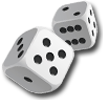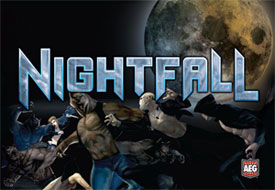



play board games
Board game reviews, strategy tips & session reports
Nightfall Review
 Stats:
Stats:
No. of players: 2-5
Amount of time to play: 45 min
Age requirements: 12+
Set-up time: 10 – 15 min
Nightfall Rules Description:
Nightfall is a horror-themed, deck-building card game that encourages an aggressive play-style. Unlike most other games in this genre there is direct player vs player combat. Can your werewolves and vampires do enough damage for you to win the game?
Nightfall shares many characteristics with other deck-building games. However it contains several new mechanics and twists. You will encounter two of these just setting up the game. There are private archives and you draft to determine some of the common archives.
You may be asking, what are archives. They are the cards that you may gain to build your deck. Nightfall starts by dealing out four marked draft cards to each player. You take one card you’d like for your private archives and pass the rest to the player on your left. Private archives are only accessible to you. You now take the cards you were passed and add one of them to your private archives. Again you pass the remainder to the left.
You choose one of these two cards to be added to the common archives. Cards in the common archives may be taken by anyone. You will have one last card. It is discarded. You then deal the top cards off the draft deck until you have eight total draft cards in common archives. To finish setting up the game count out wound cards equal to ten times the number of players. Place these cards face up on top of the rest of the wound cards and keep them within everyone’s reach.
At the beginning of the game you start with a deck of twelve starter cards (two copies of six cards). These are weaker cards that are exiled when they are destroyed or once they attack. They also only contain one link color for chaining purposes (see below).
You are now ready to start the game. Your turn will consist of four steps: Combat, Chain, Claim, Clean-up.
Combat:
The first thing that happens on your turn is any minions you have in play attack. You assign which player or players each minion will attack. If you attack a player with one or more minions in play they assign which of their minions will block your attackers. Each card has a strength and health value. If a defender’s health is met or exceeded by the attacker’s strength the defender is destroyed. Destroyed minions go in your discard pile. Any excess damage that the defender is unable to absorb gives the player wound cards. After resolving attacks attacking minions also go into your discard pile.
Chain:
Chaining is another mechanic not seen in other deck-building games. Each card has three colored moons in the upper right hand corner, one large one and two smaller ones. During this step, you may play as many cards that you can chain as you like. To chain cards you must match the large colored moon to one of the colors of the two smaller moons on the last card in the chain. Once you are finished your opponents may add cards to the chain as well.
There are only to types of cards in Nightfall orders and minions. Both may be added to the chain and both may have chain effects. Once all players have had a chance to play on the chain the chain is resolved. You start with the last card and resolve cards in the reverse order in which they were laid.
The other thing about chaining is kickers. Each non-starter card has kicker effects. These effects are triggered when you match the color of the large moon next to the kicker text to large moon on the card above it in the chain.
Resolved orders go to the corresponding player’s discard pile, but minions go from the chain to in-play. Some minions have in-play text that is followed once they are in-play.
Claim:
This is the step that adds to your deck. Each turn you get two influence to claim new cards from your private or the common archives. You can increase your influence by discarding cards. Each card you discard gives you one more influence. You may also increase you influence with some orders or minions during the chain step.
Cleanup:
During this step you draw back up to five cards. If you draw any wounds, you may discard them and draw two cards for each wound you discard. You may only do this once per cleanup so any additional wounds drawn stay in your hand.
Play continues to your left, but you will still get to play on his/her chain.
The game ends after the step in which all the face up wound cards have been drawn. If additional wound cards need to handed out during the current step they are taken from the remaining wound deck. Then you total your wound cards and the player with the lowest number of wound cards wins.
A Quick Review of Nightfall:
Nightfall is definitely a different deck-builder. It has the feel of Magic, with some Dominion mechanics and a touch of Uno. The game moves pretty fast once you get the hang of it and there is definitely some depth to it.
The chain is an interesting mechanic that keeps you involved even when it isn’t your turn. Part of the strategy is claiming cards with colors to link your cards effectively. But it will serve you well to remember what colors other players have claimed so you can get in on their chains. One session we played players constantly asked, “What color is it?” and “Change the color!” (in reference to the chain). And one person said it felt a bit like playing mean Uno.
I enjoy the draft is a fun opening mechanic, but it can slow down the setup a bit (especially if you play with someone with analysis paralysis). The beginning turns of Nightfall can be repetitive until some of the starter minions are gone. And the theme and artwork are dark, which I don’t mind, but I think they might scare my young children.
If you like direct conflict, some politicking and a game that rewards aggressive play you should enjoy Nightfall. I think the designers have left some nice areas for growth and I look forward to future expansions.
Score and synopsis: (Click here for an explanation of these review categories.)
Strategy 4 out of 6
Luck 4 out of 6
Player Interaction 5 out of 6
Replay Value 4 out of 6
Complexity 4 out of 6
Fun 5 out of 6
Overall 5 out of 6

Leave a Reply